北师大版(2019)必修第二册Unit4 Information technology Lesson3 Internet and Friendships 课件(40张ppt)
文档属性
| 名称 | 北师大版(2019)必修第二册Unit4 Information technology Lesson3 Internet and Friendships 课件(40张ppt) |  | |
| 格式 | pptx | ||
| 文件大小 | 42.5MB | ||
| 资源类型 | 教案 | ||
| 版本资源 | 北师大版(2019) | ||
| 科目 | 英语 | ||
| 更新时间 | 2022-11-13 20:47:07 | ||
图片预览


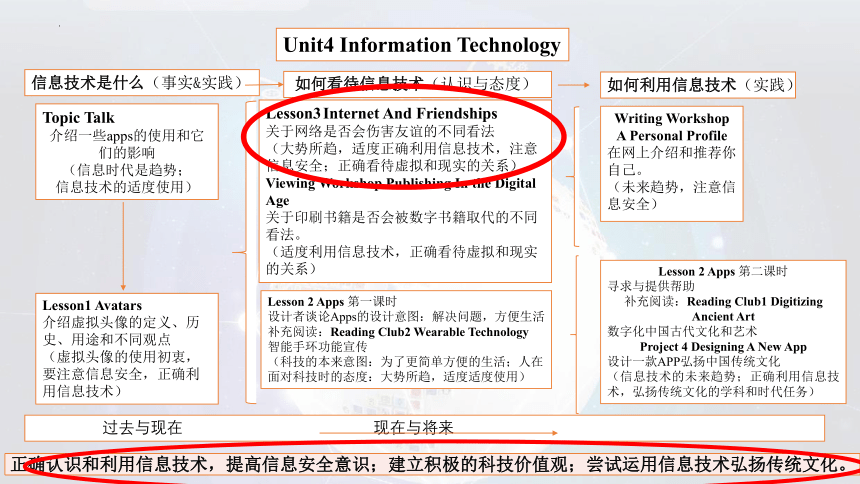
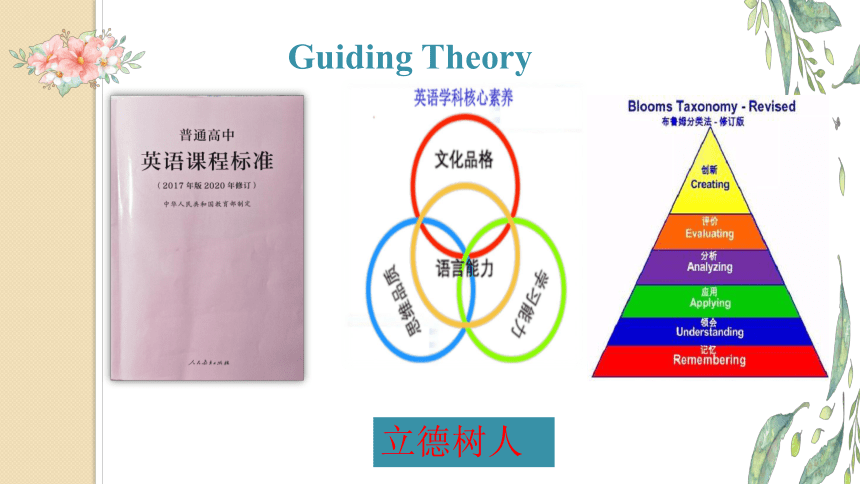
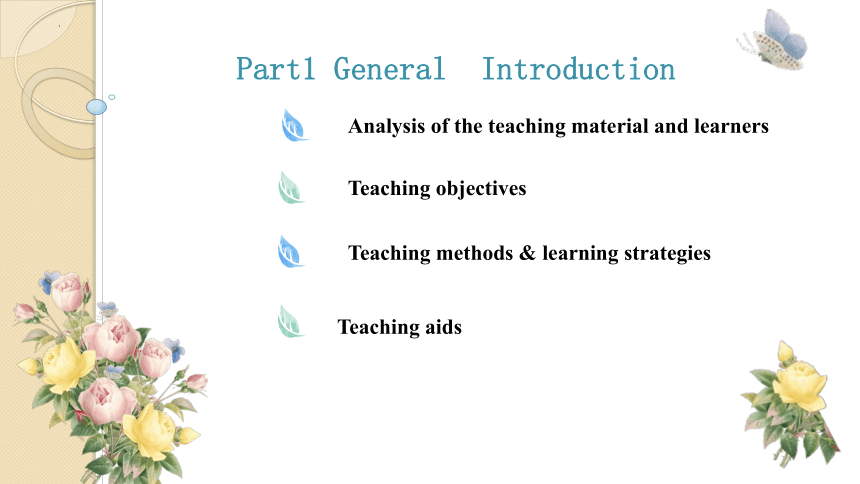
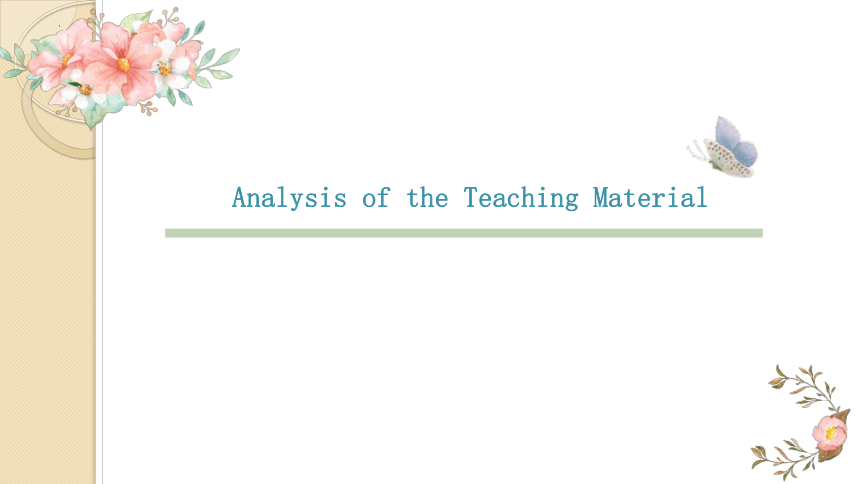
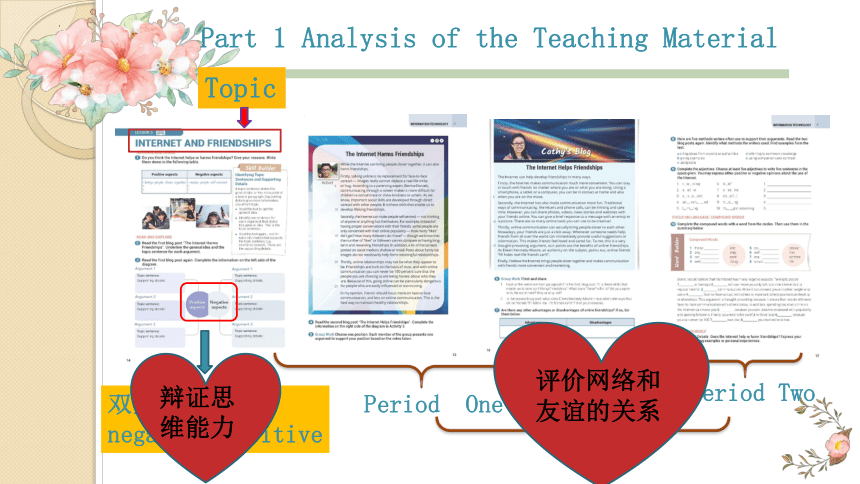
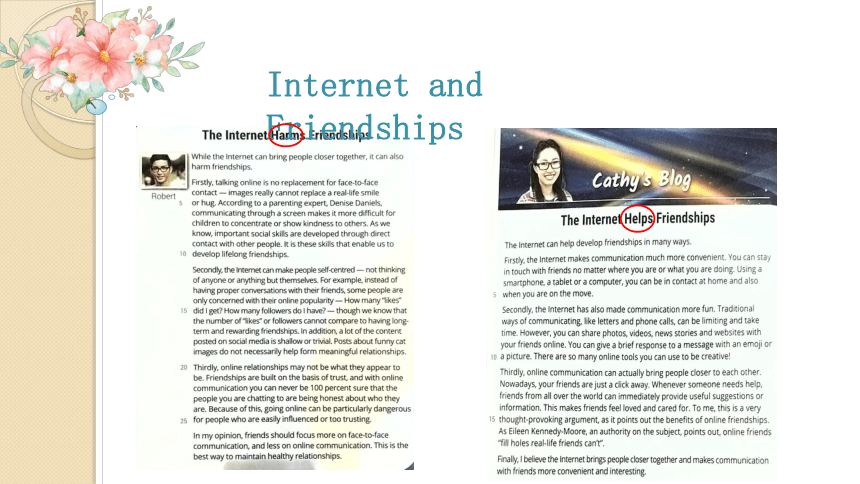
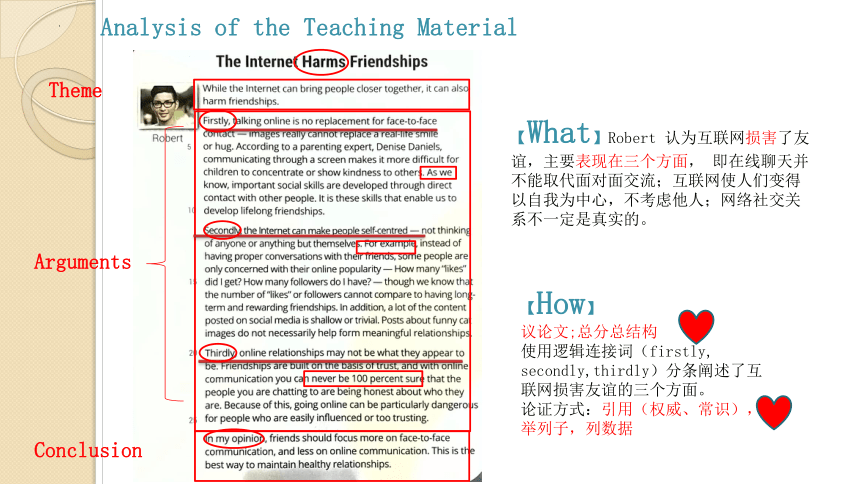

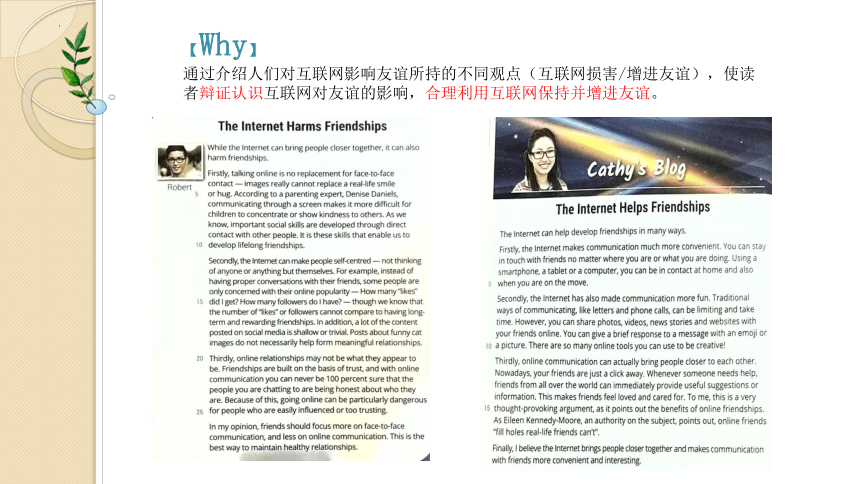
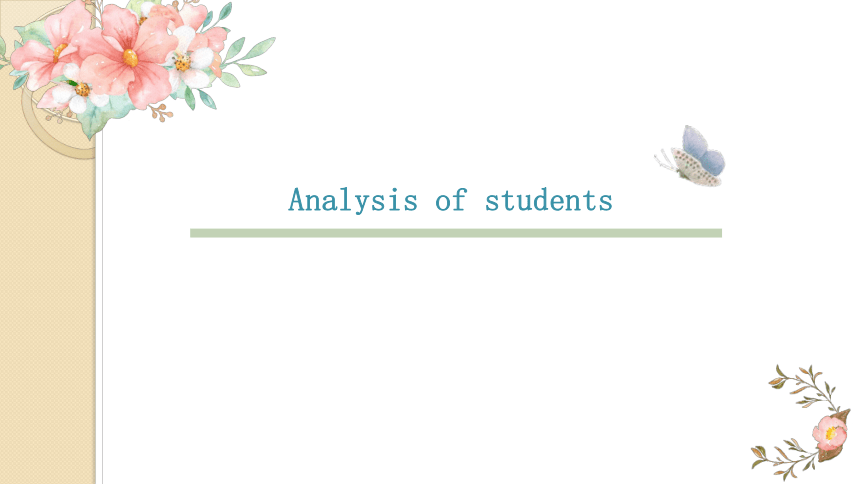
文档简介
(共40张PPT)
Internet and Friendships
——presentation of teaching plan
Lesson 3, unit 4
CONTENTS
01
General Introduction
02
Teaching Procedures
03
Features of Design
Unit4 Information Technology
Topic Talk
介绍一些apps的使用和它们的影响
(信息时代是趋势;
信息技术的适度使用)
Lesson1 Avatars
介绍虚拟头像的定义、历史、用途和不同观点
(虚拟头像的使用初衷,要注意信息安全,正确利用信息技术)
信息技术是什么(事实&实践)
Lesson3 Internet And Friendships
关于网络是否会伤害友谊的不同看法
(大势所趋,适度正确利用信息技术,注意信息安全;正确看待虚拟和现实的关系)
Viewing Workshop Publishing In the Digital Age
关于印刷书籍是否会被数字书籍取代的不同看法。
(适度利用信息技术,正确看待虚拟和现实的关系)
如何看待信息技术(认识与态度)
Writing Workshop
A Personal Profile
在网上介绍和推荐你自己。
(未来趋势,注意信息安全)
如何利用信息技术(实践)
Lesson 2 Apps 第一课时
设计者谈论Apps的设计意图:解决问题,方便生活
补充阅读:Reading Club2 Wearable Technology
智能手环功能宣传
(科技的本来意图:为了更简单方便的生活;人在面对科技时的态度:大势所趋,适度适度使用)
Lesson 2 Apps 第二课时
寻求与提供帮助
补充阅读:Reading Club1 Digitizing Ancient Art
数字化中国古代文化和艺术
Project 4 Designing A New App
设计一款APP弘扬中国传统文化
(信息技术的未来趋势;正确利用信息技术,弘扬传统文化的学科和时代任务)
过去与现在 现在与将来
正确认识和利用信息技术,提高信息安全意识;建立积极的科技价值观;尝试运用信息技术弘扬传统文化。
Guiding Theory
立德树人
Part1 General Introduction
Analysis of the teaching material and learners
Teaching objectives
Teaching methods & learning strategies
Teaching aids
Analysis of the Teaching Material
Part 1 Analysis of the Teaching Material
Period One
Period Two
Topic
双重影响:
negative/positive
辩证思
维能力
评价网络和
友谊的关系
Internet and Friendships
Analysis of the Teaching Material
【What】Robert 认为互联网损害了友谊,主要表现在三个方面, 即在线聊天并不能取代面对面交流;互联网使人们变得以自我为中心,不考虑他人;网络社交关系不一定是真实的。
【How】
议论文;总分总结构
使用逻辑连接词(firstly, secondly,thirdly)分条阐述了互联网损害友谊的三个方面。
论证方式:引用(权威、常识),举列子,列数据
Theme
Arguments
Conclusion
Analysis of the Teaching Material
【What】
Cathy 认为互联网增进了友谊,主要变现在三个方面,即互联网使交流变得更方便,更有趣,在线交流使人们彼此之间变得更加亲近。
【How】
议论文;总分总结构
使用逻辑连接词(firstly ,secondly , thirdly)分条阐述了互联网增进友谊的三个方面。
论证方式:举列子,做对比,引用(权威)
Theme
Arguments
Conclusion
【Why】
通过介绍人们对互联网影响友谊所持的不同观点(互联网损害/增进友谊),使读者辩证认识互联网对友谊的影响,合理利用互联网保持并增进友谊。
Analysis of students
Have a certain ability to obtain details in reading;
Have enthusiasm actively expressing themselves in English;
Analysis of students
Still need a guidance in logical reasoning and dialectical thinking;
Still need
Still need to have a dialectical awareness of the Internet’ effect on friendships and reasonably use it.
Language Competence
Thinking
Quality
Learning Ability
Cultural
Awareness
Teaching Objectives
Language Competence:
Teaching Objectives
1.obtain reading skills to understand the two writers’ main viewpoints.
2. identify the five common ways to support an argument: referring to experts or authorities; giving examples; using data; referring to common knowledge; using comparison and contrast.
Cultural awareness:
Teaching Objectives
1.correctly understand the positive and negative effects of the Internet on people.
2. think positively and deeply about the relationship between people and technology.
3.be aware of the network security.
Thinking Qualities:
Teaching Objectives
use mind map to summarize the text information and develop structured thinking mode.
Get dialectical thinking and diversified thinking abilities to read an argumentation;
Learning Competence:
Teaching Objectives
1.solve problems by cooperation through pair work and group discussion;
2. practice reading strategies about argumentations and develop reading habits by reordering and sorting out structures.
Key Points & Difficult Points
1.Key points:
(1)Students should dialectically think about the influence of Internet on friendships;
(2)Grasp the structure and factors of an argumentation.
2.Difficult points:
(1)Find the topic sentence and its supporting sentences correctly;
(2)Use the language points correctly to express one’ opinion related to Internet and friendships.
teaching methods
learning strategies
Ability-based teaching method
Cooperative teaching method
Inquiry teaching method
Teaching methods & learning strategies
Cognitive strategy
Monitoring strategy
Communicating strategy
Teaching aids
the multimedia equipment &blackboard
Part 2 Teaching Procedures
Pre-Reading
Activities
While-
Reading
Activities
Post-
Reading
Activities
Lead-in
Reordering the structure
Fast- reading
Careful-reading
Pair work/Group Work
Summary
Teaching Procedures
Step 1. Warm-up and pre-reading
A Questionnaire about Internet and friendships in the smart classroom
Q1: How do you make friends
A. By letters B. By emails
C. By Wechat&QQ D. Through face-to-face communication
Q2: What do your friends usually do on the Internet
A.Chatting B. Playing games
C. learning D. shopping E. watching TV…
Q3: Do you think the Internet helps or harms friendships nowadays
A. It helps friendships
B. It harms friendships
C. It has dual influences.
Design purpose: to activate the existing knowledge and prepare for the following lesson.
Pre-reading Read the slips of Robert’s blog post and organize his ideas by putting those paper slips in a proper order.
The Internet Harms Friendships
Design purpose:
Fast-reading 1
Read and Explore.
Read the first blog post “The Internet Harms Friendships.” Underline the general idea and the topic sentence for each argument.
Step 2 While-reading
Q: What does Robert think about the
influence of the Internet on friendships Why
Design purpose: have an essential understanding and get the three viewpoints of Robert.
Careful-reading 1
Read the first blog post again. Complete the information on the left side of the diagram.
Negative aspects
Topic Sentence:
Supporting details:
Argument 1
Topic Sentence:
Supporting details:
Argument 2
Topic Sentence:
Supporting details:
Argument 3
Design purpose: use the mind map to get a better understanding of the argumentation.
Q:What details does Robert use to support his argument
Step 3 Post-reading(Pair work)
Making a dialogue with your deskmate like this :
-----A: “Why does Robert think… ”
-----B: “Because…”
Design purpose : promote their ability of speaking and communication;
internalize and apply the knowledge.
Fast-reading 2
Prediction
Predict what will be talked in Cathy’ blog post.
Step 2 While-reading
Design purpose: through prediction, students can make a relation between the two posts and activate their interest in Cathy’ s post.
Fast-reading 2
Read and Explore.
Read the first blog post “The Internet Helps Friendships.” Underline the general idea and the topic sentence for each argument.
Q: What does Cathy think about
the influence of the Internet
on friendships Why
Design purpose: through skimming, students can have an essential understanding and get the three viewpoints of Cathy.
Step 2 While-reading
Careful-reading 2
Read the first blog post again. Complete the information on the right side of the diagram.
Postive
aspects
Topic Sentence:
Supporting details:
Argument 1
Topic Sentence:
Supporting details:
Argument 2
Topic Sentence:
Supporting details:
Argument 3
Design purpose: use the mind map to get a better understanding of the argumentation.
Q:What details does Cathy use to support her argument
Choose one position( positive/negative).Each member of the group presents one argument to support his/her position based on the notes taken.
Group A
Group B
The Internet
Harms Friendships
The Internet
Helps Friendships
Step3 Post-reading(Group work)
Design purpose : promote their ability of speaking;
internalize and apply the knowledge.
Negative
aspects
Topic sentence:
Supporting details:
Argument 1
Topic sentence:
Supporting details:
Argument 2
Topic sentence:
Supporting details:
Argument 3
Positive
aspects
Argument 1
Topic sentence:
Supporting details:
Argument 2
Topic sentence:
Supporting details:
Argument 3
Topic sentence:
Supporting details:
Design purpose: to review and consolidate what they have learned in this class.
Summary
Homework
1.Find more advantages and disadvantages of online friendship in Activity 7.
2. Write a short passage on Internet and friendship, using the structure of an argument.
3.Offer some helpful advice to those classmates who are confused about online friendship, if any.(optional)
Design purpose : to realize the transfer and innovation of knowledge: learn to help others.
Evaluation Methods
Peer evaluation
Teacher’s evaluation
The Blackboard Design
focus on messages
Take lots of time
Lesson 3 Internet and Friendships
communicate with others
feel less lonely
Robert
harms
No replacement for
F-T-F communication
self-centered
unreal
Cathy
helps
Much more convenient
More fun
Much closer
F-T- F communication
closer
convenient interesting
It harms/helps because…
Design purpose : to help my students grasp the detailed information step by step and understand what they have learned clearly and deeply.
Part 3 Features of Design
Features of Design
Students as the nucleus
Different activities
Diversified evaluations
Combination of reading & speaking
Thanks!
Internet and Friendships
——presentation of teaching plan
Lesson 3, unit 4
CONTENTS
01
General Introduction
02
Teaching Procedures
03
Features of Design
Unit4 Information Technology
Topic Talk
介绍一些apps的使用和它们的影响
(信息时代是趋势;
信息技术的适度使用)
Lesson1 Avatars
介绍虚拟头像的定义、历史、用途和不同观点
(虚拟头像的使用初衷,要注意信息安全,正确利用信息技术)
信息技术是什么(事实&实践)
Lesson3 Internet And Friendships
关于网络是否会伤害友谊的不同看法
(大势所趋,适度正确利用信息技术,注意信息安全;正确看待虚拟和现实的关系)
Viewing Workshop Publishing In the Digital Age
关于印刷书籍是否会被数字书籍取代的不同看法。
(适度利用信息技术,正确看待虚拟和现实的关系)
如何看待信息技术(认识与态度)
Writing Workshop
A Personal Profile
在网上介绍和推荐你自己。
(未来趋势,注意信息安全)
如何利用信息技术(实践)
Lesson 2 Apps 第一课时
设计者谈论Apps的设计意图:解决问题,方便生活
补充阅读:Reading Club2 Wearable Technology
智能手环功能宣传
(科技的本来意图:为了更简单方便的生活;人在面对科技时的态度:大势所趋,适度适度使用)
Lesson 2 Apps 第二课时
寻求与提供帮助
补充阅读:Reading Club1 Digitizing Ancient Art
数字化中国古代文化和艺术
Project 4 Designing A New App
设计一款APP弘扬中国传统文化
(信息技术的未来趋势;正确利用信息技术,弘扬传统文化的学科和时代任务)
过去与现在 现在与将来
正确认识和利用信息技术,提高信息安全意识;建立积极的科技价值观;尝试运用信息技术弘扬传统文化。
Guiding Theory
立德树人
Part1 General Introduction
Analysis of the teaching material and learners
Teaching objectives
Teaching methods & learning strategies
Teaching aids
Analysis of the Teaching Material
Part 1 Analysis of the Teaching Material
Period One
Period Two
Topic
双重影响:
negative/positive
辩证思
维能力
评价网络和
友谊的关系
Internet and Friendships
Analysis of the Teaching Material
【What】Robert 认为互联网损害了友谊,主要表现在三个方面, 即在线聊天并不能取代面对面交流;互联网使人们变得以自我为中心,不考虑他人;网络社交关系不一定是真实的。
【How】
议论文;总分总结构
使用逻辑连接词(firstly, secondly,thirdly)分条阐述了互联网损害友谊的三个方面。
论证方式:引用(权威、常识),举列子,列数据
Theme
Arguments
Conclusion
Analysis of the Teaching Material
【What】
Cathy 认为互联网增进了友谊,主要变现在三个方面,即互联网使交流变得更方便,更有趣,在线交流使人们彼此之间变得更加亲近。
【How】
议论文;总分总结构
使用逻辑连接词(firstly ,secondly , thirdly)分条阐述了互联网增进友谊的三个方面。
论证方式:举列子,做对比,引用(权威)
Theme
Arguments
Conclusion
【Why】
通过介绍人们对互联网影响友谊所持的不同观点(互联网损害/增进友谊),使读者辩证认识互联网对友谊的影响,合理利用互联网保持并增进友谊。
Analysis of students
Have a certain ability to obtain details in reading;
Have enthusiasm actively expressing themselves in English;
Analysis of students
Still need a guidance in logical reasoning and dialectical thinking;
Still need
Still need to have a dialectical awareness of the Internet’ effect on friendships and reasonably use it.
Language Competence
Thinking
Quality
Learning Ability
Cultural
Awareness
Teaching Objectives
Language Competence:
Teaching Objectives
1.obtain reading skills to understand the two writers’ main viewpoints.
2. identify the five common ways to support an argument: referring to experts or authorities; giving examples; using data; referring to common knowledge; using comparison and contrast.
Cultural awareness:
Teaching Objectives
1.correctly understand the positive and negative effects of the Internet on people.
2. think positively and deeply about the relationship between people and technology.
3.be aware of the network security.
Thinking Qualities:
Teaching Objectives
use mind map to summarize the text information and develop structured thinking mode.
Get dialectical thinking and diversified thinking abilities to read an argumentation;
Learning Competence:
Teaching Objectives
1.solve problems by cooperation through pair work and group discussion;
2. practice reading strategies about argumentations and develop reading habits by reordering and sorting out structures.
Key Points & Difficult Points
1.Key points:
(1)Students should dialectically think about the influence of Internet on friendships;
(2)Grasp the structure and factors of an argumentation.
2.Difficult points:
(1)Find the topic sentence and its supporting sentences correctly;
(2)Use the language points correctly to express one’ opinion related to Internet and friendships.
teaching methods
learning strategies
Ability-based teaching method
Cooperative teaching method
Inquiry teaching method
Teaching methods & learning strategies
Cognitive strategy
Monitoring strategy
Communicating strategy
Teaching aids
the multimedia equipment &blackboard
Part 2 Teaching Procedures
Pre-Reading
Activities
While-
Reading
Activities
Post-
Reading
Activities
Lead-in
Reordering the structure
Fast- reading
Careful-reading
Pair work/Group Work
Summary
Teaching Procedures
Step 1. Warm-up and pre-reading
A Questionnaire about Internet and friendships in the smart classroom
Q1: How do you make friends
A. By letters B. By emails
C. By Wechat&QQ D. Through face-to-face communication
Q2: What do your friends usually do on the Internet
A.Chatting B. Playing games
C. learning D. shopping E. watching TV…
Q3: Do you think the Internet helps or harms friendships nowadays
A. It helps friendships
B. It harms friendships
C. It has dual influences.
Design purpose: to activate the existing knowledge and prepare for the following lesson.
Pre-reading Read the slips of Robert’s blog post and organize his ideas by putting those paper slips in a proper order.
The Internet Harms Friendships
Design purpose:
Fast-reading 1
Read and Explore.
Read the first blog post “The Internet Harms Friendships.” Underline the general idea and the topic sentence for each argument.
Step 2 While-reading
Q: What does Robert think about the
influence of the Internet on friendships Why
Design purpose: have an essential understanding and get the three viewpoints of Robert.
Careful-reading 1
Read the first blog post again. Complete the information on the left side of the diagram.
Negative aspects
Topic Sentence:
Supporting details:
Argument 1
Topic Sentence:
Supporting details:
Argument 2
Topic Sentence:
Supporting details:
Argument 3
Design purpose: use the mind map to get a better understanding of the argumentation.
Q:What details does Robert use to support his argument
Step 3 Post-reading(Pair work)
Making a dialogue with your deskmate like this :
-----A: “Why does Robert think… ”
-----B: “Because…”
Design purpose : promote their ability of speaking and communication;
internalize and apply the knowledge.
Fast-reading 2
Prediction
Predict what will be talked in Cathy’ blog post.
Step 2 While-reading
Design purpose: through prediction, students can make a relation between the two posts and activate their interest in Cathy’ s post.
Fast-reading 2
Read and Explore.
Read the first blog post “The Internet Helps Friendships.” Underline the general idea and the topic sentence for each argument.
Q: What does Cathy think about
the influence of the Internet
on friendships Why
Design purpose: through skimming, students can have an essential understanding and get the three viewpoints of Cathy.
Step 2 While-reading
Careful-reading 2
Read the first blog post again. Complete the information on the right side of the diagram.
Postive
aspects
Topic Sentence:
Supporting details:
Argument 1
Topic Sentence:
Supporting details:
Argument 2
Topic Sentence:
Supporting details:
Argument 3
Design purpose: use the mind map to get a better understanding of the argumentation.
Q:What details does Cathy use to support her argument
Choose one position( positive/negative).Each member of the group presents one argument to support his/her position based on the notes taken.
Group A
Group B
The Internet
Harms Friendships
The Internet
Helps Friendships
Step3 Post-reading(Group work)
Design purpose : promote their ability of speaking;
internalize and apply the knowledge.
Negative
aspects
Topic sentence:
Supporting details:
Argument 1
Topic sentence:
Supporting details:
Argument 2
Topic sentence:
Supporting details:
Argument 3
Positive
aspects
Argument 1
Topic sentence:
Supporting details:
Argument 2
Topic sentence:
Supporting details:
Argument 3
Topic sentence:
Supporting details:
Design purpose: to review and consolidate what they have learned in this class.
Summary
Homework
1.Find more advantages and disadvantages of online friendship in Activity 7.
2. Write a short passage on Internet and friendship, using the structure of an argument.
3.Offer some helpful advice to those classmates who are confused about online friendship, if any.(optional)
Design purpose : to realize the transfer and innovation of knowledge: learn to help others.
Evaluation Methods
Peer evaluation
Teacher’s evaluation
The Blackboard Design
focus on messages
Take lots of time
Lesson 3 Internet and Friendships
communicate with others
feel less lonely
Robert
harms
No replacement for
F-T-F communication
self-centered
unreal
Cathy
helps
Much more convenient
More fun
Much closer
F-T- F communication
closer
convenient interesting
It harms/helps because…
Design purpose : to help my students grasp the detailed information step by step and understand what they have learned clearly and deeply.
Part 3 Features of Design
Features of Design
Students as the nucleus
Different activities
Diversified evaluations
Combination of reading & speaking
Thanks!
同课章节目录
- Unit 4 Information technology
- Lesson 1 Avatars
- Lesson 2 Apps
- Lesson 3 Internet and Friendships
- Unit 5 Humans and nature
- Lesson 1 A Sea Story
- Lesson 2 Professional Rescue Team
- Lesson 3 Race to the Pole
- Unit 6 The admirable
- Lesson 1 A Medical Pioneer
- Lesson 2 History Makers
- Lesson 3 The Superhero Behind Superman
